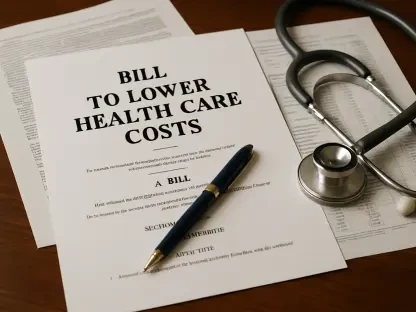The pharmaceutical industry has delivered an impressive showing in the third quarter of 2024, with several key players posting remarkable financial results that have captured the attention of investors and analysts alike. Leading the charge is Merck (NYSE:MRK), a titan in the branded pharmaceuticals space, which has not only surpassed revenue expectations but also set a high bar for innovation and market performance. This surge in earnings reflects a broader trend of resilience within the sector, as companies navigate a complex landscape of opportunities and obstacles. From groundbreaking drugs to strategic advancements, the Q3 results paint a picture of an industry poised for growth, yet challenged by external pressures. This article explores Merck’s standout performance, contrasts it with peers, and delves into the underlying trends and economic factors shaping the future of branded pharmaceuticals, offering a comprehensive look at what drives success in this vital sector.
Unpacking Merck’s Dominant Q3 Results
Merck has solidified its position as a leader in the pharmaceutical arena with an exceptional Q3 performance in 2024, reporting revenues of $17.28 billion, which marks a 3.7% increase compared to the same period last year. This figure exceeded analyst expectations by 1.7%, driven primarily by the continued success of its flagship cancer immunotherapy drug, Keytruda, alongside a robust pipeline of innovative treatments. Under the leadership of CEO Robert M. Davis, Merck has emphasized execution and forward-thinking strategies, ensuring that its portfolio remains diversified and adaptable to market demands. The market response has been overwhelmingly positive, with the company’s stock price climbing 13.4% post-earnings to trade at $98.19, signaling strong investor confidence in its trajectory. While this performance underscores Merck’s strength, potential investors are encouraged to carefully evaluate whether the current stock valuation presents a sustainable entry point for long-term growth.
Beyond the headline numbers, Merck’s success in Q3 highlights its ability to balance innovation with operational efficiency, setting it apart in a competitive field. The company’s focus on expanding its oncology offerings and investing in research and development has positioned it to address unmet medical needs, particularly in high-demand therapeutic areas. Unlike some peers who struggle with patent expirations, Merck has managed to mitigate risks through strategic product launches and partnerships that bolster its revenue streams. This proactive approach not only cushions against potential downturns but also reinforces Merck’s reputation as a reliable performer in the eyes of shareholders. Additionally, the company’s global reach allows it to tap into emerging markets where demand for advanced treatments is on the rise, further solidifying its financial foundation. As the industry evolves, Merck’s adaptability will likely remain a critical factor in sustaining its upward momentum amidst an ever-changing regulatory and competitive environment.
Contrasting Performances Across the Industry
Eli Lilly (NYSE:LLY) emerged as another heavyweight in the Q3 earnings season, achieving a staggering 53.9% year-over-year revenue increase to $17.6 billion, surpassing forecasts by 9.6%. This extraordinary growth was fueled by its strong presence in diabetes, obesity, and oncology treatments, areas with significant global demand. The market’s enthusiasm was evident as Eli Lilly’s stock price surged 30.6% to $1,060, reflecting unparalleled investor optimism about its future prospects. The company also raised its full-year revenue guidance, a move that further cemented its position as a top performer. This performance stands in stark contrast to some competitors, illustrating how targeted therapeutic focus and innovative drug development can yield exceptional results in a sector where outcomes vary widely based on strategic priorities and market positioning.
On the other end of the spectrum, companies like Corcept Therapeutics (NASDAQ:CORT) and Supernus Pharmaceuticals (NASDAQ:SUPN) presented a more mixed picture during Q3. Corcept reported a solid 13.7% revenue growth to $207.6 million but fell short of analyst expectations by 5%, though its stock still rose 11.7% to $79.39, suggesting investors are betting on future potential. Supernus, meanwhile, achieved a 9.3% revenue increase to $192.1 million, beating estimates by 3.5%, but a significant miss on earnings per share and a weak full-year guidance update led to a 20.5% stock price drop to $45.32. These contrasting outcomes highlight the diverse challenges within the sector, where revenue gains do not always translate to overall financial health or market approval. The variability in performance underscores the importance of not just meeting financial targets but also aligning with investor expectations on broader metrics like profitability and long-term growth strategies.
Driving Forces Behind Sector-Wide Growth
The branded pharmaceuticals sector as a whole demonstrated notable strength in Q3 2024, with a collective revenue performance that exceeded consensus estimates by an average of 2.3%. This achievement was accompanied by an average stock price increase of 6.6% following earnings announcements, pointing to sustained investor confidence in the industry’s stability and potential. Key tailwinds propelling this growth include rapid advancements in precision medicine, which allow for more targeted and effective treatments, as well as the integration of artificial intelligence in drug discovery processes to enhance efficiency. Additionally, rising global demand for therapies addressing chronic conditions and rare diseases has created fertile ground for revenue expansion. These factors collectively position the sector as a critical player in healthcare, capable of meeting evolving patient needs while delivering value to stakeholders amidst a dynamic market landscape.
However, the path forward is not without significant hurdles that temper the optimism surrounding Q3 results. Headwinds such as patent cliffs threaten to erode revenue from blockbuster drugs as generics enter the market, compelling companies to accelerate innovation to replace lost income. Regulatory scrutiny continues to intensify, with governments and insurers pushing for lower drug prices, which squeezes profit margins and complicates pricing strategies. These challenges are compounded by geopolitical uncertainties that could influence trade policies affecting pharmaceutical supply chains. Despite the positive earnings momentum, the sector must navigate these obstacles with agility, ensuring that investments in research and development are balanced against cost pressures. The ability to adapt to these external forces while maintaining a commitment to groundbreaking therapies will likely determine which companies sustain their growth trajectory in the coming quarters.
Economic Context and Emerging Challenges
The broader economic environment has provided a supportive backdrop for the pharmaceutical sector’s strong Q3 performance in 2024, with the U.S. economy achieving what many describe as a “soft landing” after earlier Federal Reserve rate hikes aimed at curbing inflation. Subsequent rate cuts in September and November of 2024, at 0.5% and 0.25% respectively, have invigorated equity markets, contributing to a robust year for stock performance across industries. This favorable climate has allowed pharmaceutical companies to attract investment capital, facilitating expansion and innovation initiatives. However, while the current economic stability benefits the sector, it also masks underlying vulnerabilities that could surface if inflationary pressures resurge or if monetary policy shifts unexpectedly, potentially impacting the cost of capital for research-intensive firms reliant on external funding.
Adding to the complexity, recent political developments following the November 2024 election have introduced both opportunities and uncertainties for the pharmaceutical industry. The market gains spurred by the election outcome reflect optimism about potential deregulation or favorable corporate tax adjustments, yet looming questions around tariffs and trade policies could disrupt global supply chains critical to drug manufacturing. For an industry already grappling with pricing pressures and regulatory oversight, these economic and political variables add another layer of risk that must be carefully monitored. Companies will need to prepare for scenarios where policy changes could directly affect drug affordability mandates or import costs, influencing their strategic planning. As the sector looks ahead, maintaining flexibility in response to these external dynamics will be essential to preserving the momentum gained from an otherwise stellar quarterly performance.
Innovation as the Pillar of Future Growth
Innovation stands out as the cornerstone of sustained success in the branded pharmaceuticals sector, a theme vividly illustrated by the Q3 2024 earnings results. Companies like Merck and Eli Lilly have demonstrated how strategic investments in research and development can translate into substantial financial gains, particularly through drugs targeting high-need areas such as oncology and metabolic disorders. Their ability to bring novel therapies to market not only addresses critical health challenges but also builds a competitive moat against rivals facing revenue losses from patent expirations. The emphasis on cutting-edge solutions, including the use of AI to streamline clinical trials, reflects a broader industry shift toward efficiency and precision, ensuring that resources are directed toward the most promising therapeutic breakthroughs with the potential for widespread impact.
Yet, the reliance on innovation also reveals the stark disparities in outcomes across the sector, as not all companies are equally equipped to capitalize on emerging trends. Smaller players or those with less diversified portfolios often struggle to match the pace of R&D investment required to stay relevant, as seen in the mixed results of firms like Supernus Pharmaceuticals. This variability serves as a reminder that while innovation drives growth, it demands consistent execution and substantial capital, which can strain financial resources if not managed prudently. Moreover, external pressures such as government intervention in drug pricing or shifts in healthcare policy could undermine the returns on these investments, necessitating a delicate balance between risk-taking and fiscal responsibility. As the industry progresses, fostering a culture of innovation while navigating these challenges will be pivotal for companies aiming to replicate the success of top performers in future quarters.
Reflecting on a Quarter of Resilience
Looking back at the third quarter of 2024, the branded pharmaceuticals sector displayed a commendable ability to thrive under pressure, with Merck leading a cohort of companies that collectively outperformed revenue expectations by 2.3% and saw stock prices appreciate by an average of 6.6%. The standout achievements of firms like Merck and Eli Lilly underscored the power of strategic focus on high-growth therapeutic areas, while the struggles of others highlighted the inherent risks of a competitive and regulated market. Despite facing patent cliffs and pricing constraints, the industry leveraged tailwinds like technological advancements to maintain momentum. Moving forward, stakeholders are encouraged to prioritize in-depth analysis of individual company fundamentals over sector-wide trends, as execution will remain the differentiating factor. Additionally, staying attuned to evolving economic and policy landscapes will be crucial for anticipating shifts that could redefine the competitive dynamics in this essential field of healthcare.









